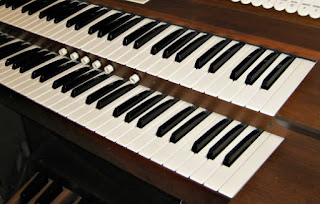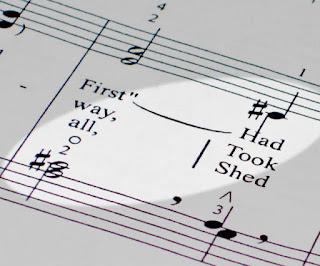
It's finally time to discuss the huge difference between piano and organ technique.
Posture
In past lessons we've discussed how to adjust the organ bench and how to center yourself on the pedal board. Now we'll discuss proper posture for manual playing.
It's very important to sit up straight while keeping your body relaxed and keeping the lumbar curve. Your wrists, elbows, and shoulders should be relaxed, with the elbows bent ninety degrees. Practicing on the lower manual as often as possible will help keep proper posture.
If you have long nails, it's time to bid them farewell. I've been guilty of playing with longer nails, and it's impossible to practice proper technique with nails in the way. (Some of my earlier videos show my poor technique that was necessary to compensate for long nails.) Once your nails are trimmed, place your curved fingers on the keys, and play by pulling the fingers towards you--instead of pushing down, pull inward.
Techniques
Regular, or Direct Fingering
This fingering technique mirrors piano technique. Placing fingers on adjoining keys, the fingers play and stretch or compress to play the notes without crossing or utilizing any other techniques.
Redistributing the Inner Part
Since the bass part is played with the pedals, the left hand only needs to play the tenor part. Many times the soprano and alto parts are difficult to finger with the right hand, so the left hand can grab the alto part--it is redistributed to the left hand.
Finger Crossing
Pianists are familiar with this technique--especially in scale exercises. Generally, a longer finger crosses over a shorter one, or a shorter finger crosses under a longer one. However, exceptions can be made in different circumstances.
Here is a simple exercise to practice up and down the keyboard:
Finger Glissando The finger or thumb slides from one note to another, from a black key to a white key.
Thumb Glissando The thumb glissando differs from playing a finger glissando with the thumb--it occurs from white key to white key, or white key to black key, a technique we will cover in a later lesson.
Finger Substitution In finger substitution, one finger is replaced by another during the same note so that the first finger is free to play another note.
Independent Movement One finger will sustain notes while another will lift. Different horizontal lines will operate independently, while being played by the same hand. This technique is essential to organ playing, and one that we will cover today.
Common Tones and Tying
Common Tones

Common tones are notes that are shared between voices in succession. For example, in hymn 198, "That Easter Morn," the D in the soprano/alto part in the first measure carries over to the alto part in measure two. lifting that D would create a break in the soprano/melody, so that D is tied.

The alto line on beat three of measure 6 is an F that is repeated in the soprano/alto on beat one of the next measure. A lift is necessary so that the melody is clear.

In measure 8, the C# in the tenor is repeated in the soprano/alto in beat three. It's important to lift so that the melody is heard and not just muddied into. As you can see, when the line above is ascending, the notes generally tie, as in the first example, and when the line above is descending, the notes generally break, as in the second and third example.
Tying Rules

In some hymns, all four voices repeat. Picking up and replaying all voices can cause a very choppy, non-legato sound. In this case, it is a good idea to tie one or two voices, depending on the speed of the hymn, to ensure that the hymn retains a legato sound. Never tie over bar lines (the only time you do this is to observe a common tone rule), and make sure you tie from strong beats to weak beats, not from weak beats to strong beats.
Practical Application
Break out Carol Dean's Hymns from the L.D.S. Hymnal Marked for the Organ, Hymn 285. In the last lesson we learned the pedaling for this hymn. Today we'll discuss the manual technique.
***Disclaimer: Carol is continually editing and changing the markings on these hymns. Your version may be slightly different from my 2006 version.***
Generally, in playing a hymn you will proceed similarly to the pedal technique we covered last time. When a note is repeated, lift and replay it. If a note changes, keep the legato line with no break or overlap. However, unlike the pedal technique we covered, there are times when common tones or tying rules come into play.
You'll notice that in the first full measure of "God Moves in a Mysterious Way," all four parts repeat. The alto part is tied through four beats to provide the legato discussed above. The alto part is also redistributed to the left hand. Practice just the left hand, Bb and G with fingers 2 and 4, holding the Bb as the G lifts on the last half of the beat through those first three beats, then the G holds through the fourth beat as the Bb lifts in preparation for beat five.
In measure three the right hand plays a similar passage, using fingers 1 and 3 on D and F. Play the D and F, hold the D while the F holds for 1/2 count, rests, three times, then provides a full count before direct fingering to Eb and G with fingers 2 and 4.
In measure five, the right hand again plays similarly, but with 2 and 4 on Eb and G.
As you practice, pay very careful attention to the breaks and legato fingerings. It may be helpful to play just the soprano, then just the alto, then just the tenor, then just the right hand, then just the left hand. Take your time, and only play as quickly as you can play perfectly. It may seem painfully slow, but slow is essential to learning proper technique. The organ is so different from the piano, that you are learning a brand new technique on a brand new instrument.
Here is the right hand:
Homework
Learn the manual parts of this hymn this week. Work slowly and don't become frustrated if your progress is slower than you'd like. You are learning a brand new technique, and that takes a lot of time and practice. It will get easier, eventually, if you put in the necessary time and effort. The metronome marking in the Hymnal is 58-69 for the half note, which is 116-138 for the quarter note. Do not start anywhere near that fast, but eventually work up the speed, slowly, never playing faster than you can play perfectly. Review the bass part in the pedals that we covered last time, and slowly increase the tempo.
DO NOT put the manual and pedal parts together yet. We'll discuss how to best accomplish this in the next lesson. Practice the finger crossing outlined above. Play C and E with 1 and 3 of the left hand. Play D and F with 2 and 4. Play E and G with 1 and 5. Play F and A with 2 and 4. Play G and B with 1 and 5, etc. Then move back down. Repeat with the left hand an octave lower, but play C and E with 5 and 3, D and F with 4 and 2, E and G with 5 and 1, F and A with 4 and 2, etc. Then move back down.
In Conclusion
"God Moves in a Mysterious Way" is a good introduction to organ technique. While the hymn is quite simple, this new technique is not.
Once the manual and pedal parts are learned independently, we'll learn the best way to put them together in Lesson 9: Playing your First Hymn.




No comments:
Post a Comment